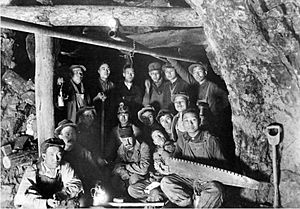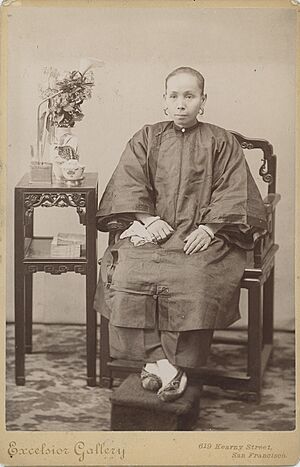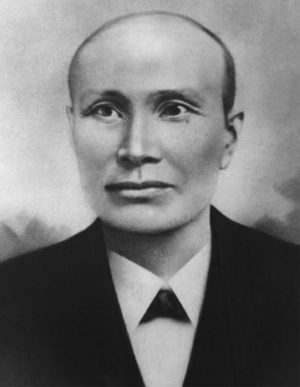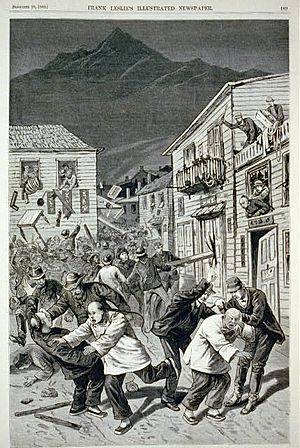History of Chinese Americans in Colorado facts for kids
People of Chinese descent have lived in Colorado since the mid-1800s. Many came from China looking for work. These Chinese immigrants had a big impact on Colorado's history and culture. They built communities across the state, including Chinatown, Denver. However, their numbers went down because of violence and unfair rules. As of 2018, about 45,273 Chinese Americans live in Colorado.
Contents
History of Chinese Americans in Colorado

Chinese immigrants helped build Colorado. Like in many Western states, the first Chinese immigrants came to Colorado for tough jobs. These jobs included building railroads and working in mines.
Early Chinese Immigrants (1869-1900)
Chinese immigrants first arrived in Colorado in 1869. Many worked for big railroad companies like the Central Pacific Railroad and Union Pacific Railroad. They helped finish the transcontinental railroad. People at the time thought Chinese workers were a good choice because their labor was more affordable. This helped Americans doing hard work in the West.
Mining also brought many Chinese immigrants to Colorado. Park County was a very important mining area. It had several Chinese mining camps. Chinese immigrants lived near towns like Hamilton, Como, and King. Most lived near Fairplay, where they created a small Chinatown. In Fairplay, Chinese immigrants worked as miners, servants, cooks, housekeepers, laundry workers, and shopkeepers. People who hired them in Park County saw them as strong and reliable workers.

The Chinese also settled in Denver. Many opened laundries because the city had many men who needed their clothes washed. By 1870, a street called "Chinaman's Row" was set up on Wazee Street in Denver. Forty-two Chinese immigrants lived and worked there. By 1890, "Chinaman's Row" became Chinatown, Denver. At its busiest, 980 people lived there.
The Anti-Chinese Riot of 1880
Chinese immigrants in Colorado faced a lot of unfair treatment. This was similar to other parts of the United States. Many who moved to Colorado from California had already seen violence against Chinese people. During an economic downturn in 1873, strong dislike and unfair actions against Chinese people grew. This unfair treatment was often seen in Colorado newspapers. These papers used mean names and insults against Asian Americans.
These words turned into actions in many places. In 1874, white miners forced 160 Chinese immigrants out of Nederland, Colorado. In 1879, Leadville, Colorado proudly said it had no Chinese people living there.
In 1880, tensions became very high during the 1880 United States presidential election. The issue of Chinese immigration became a national topic. On October 30, 1880, supporters of a presidential candidate marched through Denver. They carried signs with anti-Chinese messages. The next evening, a large group of white people started a riot in Chinatown. Almost every building there was burned down.
In the sixty years after the riot, fewer Chinese people lived in Colorado. In 1890, there were 1,398 Chinese people in the state. By 1940, this number had dropped to only 216. Chinese communities in Colorado slowly disappeared.
Notable Chinese Americans in Colorado
Many Chinese people made huge contributions to the United States and Colorado. They built the transcontinental railroad and helped with farming. They were also pioneers in science and engineering. Many became dentists, doctors, lawyers, leaders, and business owners. They were also political and social activists, as well as neighbors and friends.
Chin Lin Sou (1836-1894)

Chin Lin Sou (1836-1894) came to the United States from Guangzhou, China, in 1859. He was one of the first Chinese immigrants in Colorado. He led the first group of Chinese laborers to work on the Central Pacific Railroad. In 1871, Chin moved to Colorado. He worked as a contractor, managing Chinese placer miners in Black Hawk.
Later, he became a merchant in Gilpin County and Denver. He imported food, clothing, and furniture from China. He also started groups that supported Chinese businesses and communities in Colorado. Because of this work, he was called the “Mayor of Chinatown” in Denver. Chin brought his wife from China in 1873. Their first child, Lily, is thought to be the first Chinese American child born in Colorado. They had six children in total.


